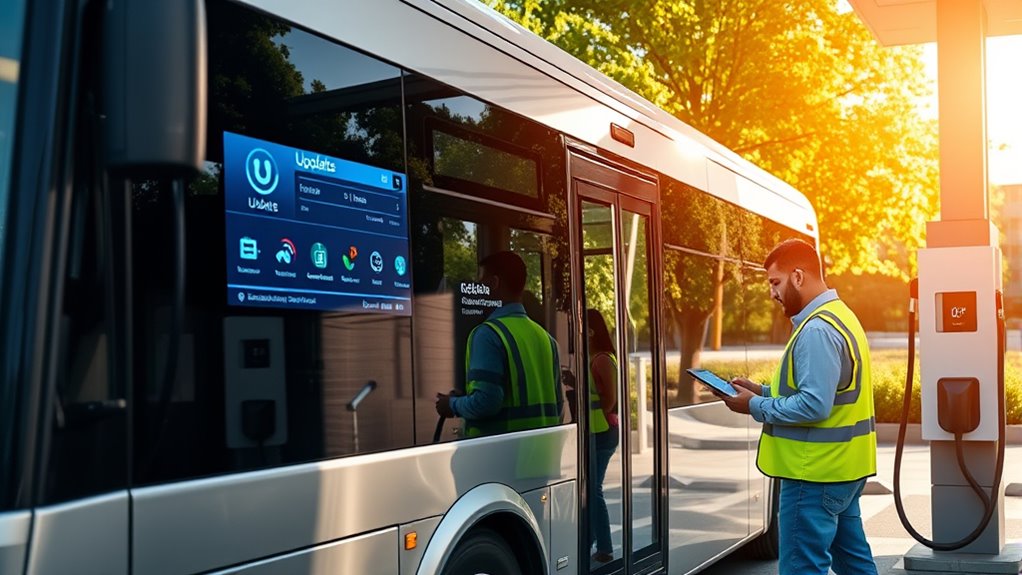Regular software updates are essential for keeping your electric bus running efficiently, safely, and reliably. They optimize battery performance, enhance safety features, and improve the user experience. Updates also support proactive maintenance, reduce costs, and help your vehicle adapt to new technologies like autonomous driving. Staying current ensures your bus meets safety standards and operates at its best in a constantly evolving landscape. Keep exploring to discover how these updates can benefit your fleet even more.
Key Takeaways
- Regular updates optimize battery life and extend driving range, improving operational efficiency.
- They enhance safety features and ensure compliance with evolving safety standards.
- Software patches fix cybersecurity vulnerabilities, protecting against cyber threats.
- Updates improve infotainment and passenger interfaces, boosting user experience.
- Continuous improvements support autonomous driving capabilities and future technological advancements.

Have you ever wondered how electric buses stay safe, efficient, and up-to-date? The answer lies in the essential role that software plays in their operation. Software manages everything from battery health to power distribution, guaranteeing that each component works harmoniously. Regular updates are imperative because they optimize battery performance, which directly enhances efficiency and extends the bus’s driving range.
Software ensures electric buses run safely, efficiently, and stay up-to-date by optimizing performance and extending driving range.
When the software is improved, you get better energy management, meaning the bus can travel further on a single charge, saving operational costs and reducing downtime. Powerful persuasive words can also be incorporated into update communications to keep fleet managers and drivers informed and engaged regarding new features and improvements.
Safety is another critical aspect that software updates address. Modern electric buses rely on advanced safety features like anti-lock braking systems (ABS) and traction control, which depend heavily on software algorithms. Updating the software guarantees these safety systems function correctly and incorporate the latest safety standards. This ongoing process helps prevent accidents and keeps passengers and drivers secure.
Plus, the user experience benefits from software improvements. Infotainment systems and passenger interfaces become more intuitive and responsive, making the ride more comfortable and engaging for everyone onboard.
One of the biggest advantages of software updates today is the ability to perform them remotely through over-the-air (OTA) technology. This means you don’t need to bring the bus into a workshop for updates; they can happen seamlessly in the background. OTA updates save time and money by reducing the need for physical maintenance visits, allowing fleet managers to deploy improvements quickly.
They also enhance security by promptly patching vulnerabilities and addressing potential cyber threats, which is essential as electric buses become more connected. This real-time updating process helps maintain compliance with evolving regulations, ensuring the fleet stays within legal standards.
Software also plays a key role in maintaining fleet efficiency. It continuously monitors vehicle conditions, enabling predictive maintenance that minimizes unexpected breakdowns. This proactive approach reduces downtime, keeping buses on the road longer and improving overall productivity.
Data collected from the software supports better decision-making, guiding resource allocation and maintenance scheduling. Additionally, these updates help optimize energy consumption, making the operation more sustainable and environmentally friendly.
Cybersecurity is an ongoing concern for connected electric buses. Regular software updates protect against cyber threats by fixing vulnerabilities and ensuring secure data transmission between the vehicle and infrastructure. This ongoing security work is essential to prevent unauthorized access and safeguard sensitive information.
When integrated with maintenance software, these updates streamline upkeep processes, helping vehicles meet safety standards and reducing costs associated with unnecessary repairs.
In the sphere of autonomous driving, software updates are indispensable. They refine and improve algorithms that control autonomous features, ensuring these systems operate safely and efficiently. As technology advances, continuous updates help develop more reliable autonomous capabilities, pushing electric buses closer to fully self-driving transportation.
In short, regular software updates are the backbone of safe, efficient, and innovative electric bus operations, enabling continuous improvements that benefit everyone involved.
Frequently Asked Questions
How Often Should Electric Bus Software Be Updated?
You should update your electric bus software regularly, ideally every 4 to 12 weeks, depending on the manufacturer’s protocol. Frequent updates help improve battery management, fix safety issues like thermal faults, and enhance cybersecurity.
Keep an eye on critical patches that may need immediate installation, especially for safety-related fixes. Regular updates also guarantee compatibility with charging infrastructure and prevent unexpected downtime, keeping your fleet running smoothly and safely.
Can Outdated Software Cause Safety Issues in Electric Buses?
Ever wondered if outdated software could jeopardize safety? It definitely can. When your electric bus runs on old software, it risks glitches, poor battery management, and failure of safety systems like fire suppression or collision avoidance.
These issues can lead to accidents or fires. Regular updates keep all safety features functioning correctly, reducing risks. Without timely updates, you’re leaving safety gaps that could have serious consequences for passengers and operators alike.
Are Software Updates Costly for Fleet Operators?
You might wonder if software updates cost too much for your fleet. While prices vary—covering licensing, setup, and subscription fees—they can lead to significant savings.
Updates optimize charging, reduce energy costs, and improve efficiency, often outweighing their costs. Plus, they help you stay compliant and ready for future tech.
Do Updates Require Bus Downtime or Service Interruption?
You might wonder if software updates cause bus downtime or service interruptions. Usually, updates are scheduled during low-traffic periods or maintenance windows, minimizing disruptions.
Advanced planning and technology, like AI and real-time monitoring, help reduce the time buses are out of service. Properly managed, updates keep your fleet running smoothly without substantially impacting daily operations, ensuring safety, performance, and reliability.
How Do Software Updates Improve Electric Bus Performance?
You might wonder how software updates boost electric bus performance. They help by providing real-time data for better route planning, energy management, and predictive maintenance, which reduces breakdowns.
Updates also optimize charging schedules and improve fleet tracking, ensuring your buses run efficiently and reliably.
Conclusion
Imagine cruising down the road, your electric bus running smoothly, every system humming in perfect sync. Regular software updates act like a vigilant navigator, steering you clear of glitches and ensuring peak performance. They’re the unseen hands behind a safer, more reliable journey—like fresh paint on a familiar canvas. Keep your bus up-to-date, and you’ll enjoy a seamless ride every time, knowing you’re driving into a future that’s better, brighter, and more efficient.





